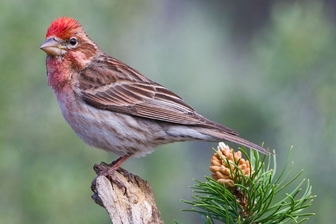Cassin's finch
Cassin's Finch is a bird in the finch family Fringillidae. This species and the other American rosefinches are usually placed in the rosefinch genus Carpodacus, but they likely belong in a distinct genus Burrica.

The Cassin's finch is classified as Near Threatened (NT), is close to qualifying for or is likely to qualify for a threatened category in the near future.
Cassin's Finch (Carpodacus cassinii) is a bird in the finch family Fringillidae. This species and the other "American rosefinches" are usually placed in the rosefinch genus Carpodacus, but they likely belong in a distinct genus Burrica. Adults have a short forked brown tail and brown wings. They have a longer bill than the Purple Finch. Adult males are raspberry red on the head, breast, back and rump; their back and undertail are streaked. More
grosbeaks Cassin's Finch ("Carpodacus" cassinii) is not part of the genus Carpodacus proper Pallas' Rosefinch (Carpodacus roseus), a true rosefinch Hooded Siskin (Carduelis (Spinus) magellanica) ʻIʻiwi (Vestiaria coccinea), a Hawaiian honeycreeper Male Violaceous Euphonia (Euphonia violacea) The systematics of the cardueline finches are contentious. The layout presented here follows the recent decades' molecular phylogenetic studies, and takes into account the traditional splitting of the genus Carduelis. The exact position of several genera in the cardueline sequence is tentative. More
Cassin's Finch is a common bird of the western mountains. More
North American RangeThe Cassin's Finch is closely related to the Purple Finch and the House Finch, and there are places in Washington where all three species can be found. Like most finches, the Cassin's Finch has a notched tail. The male Cassin's Finch typically has a brown back and wings, with pinkish over-wash and white belly. His brightest coloring is on his crown. This bright spot contrasts with the relatively pale areas surrounding it and is a good field mark. More
Cassin's Finch shows a slightly larger, chunkier body with a large head. This species has a shorter, deeply notched tail and often appears to have a peaked crown. The slightly longer bill is heavy and conical with nearly straight culmen (top of the bill). Listen to song. More
Often found at high altitudes, the Cassin's Finch is a locally common and conspicuous resident of western mountain conifer forests, especially spruce and fir trees. Males sing from treetop song perches or during smooth horizontal sallies on slow wing beats known as "moth flights." These flights are most common during the breeding season, which extends from April through early June. Breeding adult males stop singing when nest building begins, and, as befits a semicolonial species, song is not important in territorial defense. More
The Cassin's Finch is currently rated as Near Threatened. This is an upgraded rating from Lower Risk in 2000. Cassin's Finch is native to southern portions of Canada and the Rocky Mountain region of the United States. It tends to winter in northern Mexico. It is believed that the primary threat to this bird species is logging. Overall, the population of Cassin's Finch has declined by more than 2% per year over the last several decades. More
Bent Life History for the Cassin's Finch - the common name and sub-species reflect the nomenclature in use at the time the description was written. CASSIN'S FINCH CARPODACUS CASSINII Baird HABITS Contributed by ROBERT THOMAS ORR Cassin's finch is a bird of the high, cool, semiarid, coniferous forests of western North America. More
The Cassin's Finch was named for Philadelphia ornithologist John Cassin. Cassin, 1813 - 1869, was made honorary curator of the Philadelphia Academy of Natural Sciences in 1842. There are five species of western bird that bear his name. More
I know Cassin's finches are around Oasis Valley first when I hear their peculiar calls, which to me sounds like "sillit" or "psilit". House finches have more musical "chewip" or "vweet" calls. They appear in our area in spring, and even more in fall, sometimes seeming to replace the summer population of House finches at my feeders, although they are never as common. Csssin's finches are common breeders in most of Nevada's higher mountain ranges in conifer forests. More

Family : Fringillidae
Genus : Carpodacus
Species : cassinii
Authority : Baird, 1854
